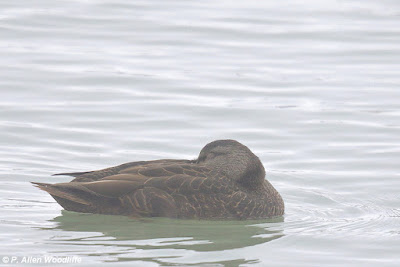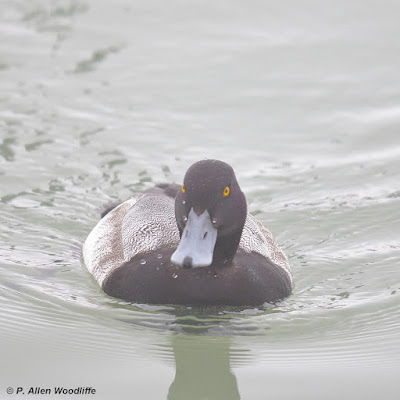The Wallaceburg/Walpole Island Christmas Bird Count was last weekend, and as usual I joined in on the fun. My territory includes a long section of the St. Clair River north of Walpole Island as well as some inland areas. Usually the river is quite productive for waterfowl diversity, although this year wasn't one of those banner years. There was no ice on the river at all, not surprisingly given the warmer than usual weather. Overall there was an average diversity, and some were even close enough to get a few decent photos in spite of the gloomy light conditions. At least there were no harsh shadows caused by the bright sun!
While most ducks are generally well out from any access point, the protected area downstream from the former ferry access at Sombra never disappoints. There are always several dozen ducks to be seen, and are often quite close to shore where one can photograph them from a vehicle, with a little help from a good telephoto lens.
Redheads were one of the more common species to be seen.
A duck closely related to Mallard is this American Black Duck, shown next. It used to be much more common than Mallard in Ontario, at least at the time of settlement and shortly afterwards. Their preferred breeding habitat is wooded wetlands, which are far less available in the past century or more.
Scaup were in good numbers as well, with the Greater Scaup, shown first, the most plentiful. Even at rest, they are easily separated from the Lesser Scaup by the rounded shape of the head.
Another feature to use, when visible, is the width of the black tip of the bill. This next photo shows the narrower black tip on a Lesser, compared to a black tip almost twice as wide on a Greater.
When the Lesser Scaup is resting, note the more peaked top of the head with a slight notch visible....
...the notch is also visible when the bird is not at rest.
Canada Geese are often quite abundant somewhere in my territory, but not so much this year. I saw a few out in a field, and a few in flight, but not nearly as many as usual.
One of the highlights for me was not so much a rare bird, but an opportunity to watch an adult Red-tailed Hawk in action. Most of the time when a vehicle approaches a hawk on a post, the bird leaves quickly even before the vehicle comes to a stop. I saw this bird on a post and decided to approach slowly to see what would happen. Instead of flying off, the bird dropped to the ground beneath it and proceeded to investigate the grassy ground cover. It was not perturbed enough to leave, and in fact even after I got a bunch of photos, I left and it was still probing the grass with its talons, probably hoping to grasp on to a mouse or vole that it had heard scurrying around.
The road I was on was not busy at all, fortunately, and the bird allowed me to get so close that I had to change my lens down to my 100-400 and even zoom back to about 300mm in order to get these photos. They are hardly cropped at all.
I'm not sure if the hawk was successful or not, as I went on my way after a few minutes and the bird was still hunting.
Photographing birds against the sky was not nearly as successful. I did manage to get a couple of shots of a somewhat wary Northern Flicker, but against the very bland grayish white sky the result was not wonderful. Even after a fair bit of processing, this is the best I could do.
My total for the day was a mere 32 species, quite a bit lower than my usual total of around 40 for this area. But land birds were few and far between and, as mentioned, even the water birds were less abundant than usual. The final total overall was 82 species.
A day or two later I went back out to Keith McLean Conservation Lands, hoping to have a more successful result in looking for the Nelson's Sparrow and Least Sandpiper. The previous two times I was out, the wind was much stronger than I had hoped, and had zero success at finding either of these birds. On this day, while it wasn't totally calm, it was much improved. On the way, I had a couple of Bald Eagles fly over, including this 3rd year bird which at one point almost flew directly overhead.
A muskrat was scurrying around at the water's edge before it realized a human was quite close by, causing it to scamper for deeper water.
I finally came across the Least Sandpiper, and it gave me some very good views and photo ops. I'm not sure how it will fare over the next few days with the weather forecast being what it is.
I did not see the Nelson's Sparrow, although there were a lot of sparrows moving through the cattail vegetation and disappearing before I could get a good look. There was the usual mix of American Tree Sparrows, Savannah Sparrows and Swamp Sparrows, but I could not pick out a Nelson's.
Just east of Shrewsbury, I came across a flock of 27 Sandhill Cranes feeding at the edge of a field.
In other news, the American Bird Association has announced its annual choice for Bird Of The Year. Usually it is a species that has more relevance to Ontario than this particular choice, and in the past it has included such species as Green Heron and Cedar Waxwing. However the BOTY for 2022 is Burrowing Owl, an impressive little owl with its piercing eyes, no question.
There has been the occasional record for Ontario, including one back in the late 1970s showing up at McGeachy Pond Conservation Area just outside of Erieau. A few years later one showed up briefly on Pelee Island. I saw the McGeachy Pond one, but did not get any photos. The bird shown here was scanned from a slide I took of one at the Grasslands National Park in Saskatchewan, back in 1986.
Tomorrow, January 1, 2022 is the 43rd St. Clair National Wildlife Area Christmas Bird Count. We've averaged slightly over 82 species over the last decade, with a high of 93 species in 2019. It will be interesting to see how this count fares, but given the deteriorating weather over the course of the day, won't likely set any new overall records. The record for Snowy Owls, currently at 18, may be in jeopardy, however. I was out yesterday and saw 12 different birds in a small, but important part of the count circle. There could easily be twice that many overall, but the question will be, will they be sitting out in a visible location if the forecast rain comes to pass?
Yesterday they were sitting up nicely, with 4 of them on poles or grain bins close to the road, while the others were well out in a field, or beside a post.
Happy New Year!
If you want to subscribe, or unsubscribe, to Nature Nuggets, send an email to prairietramper@gmail.com
























Happy New Year Allen! Great chance to photograph thecRed-tailed Hawk.
ReplyDelete